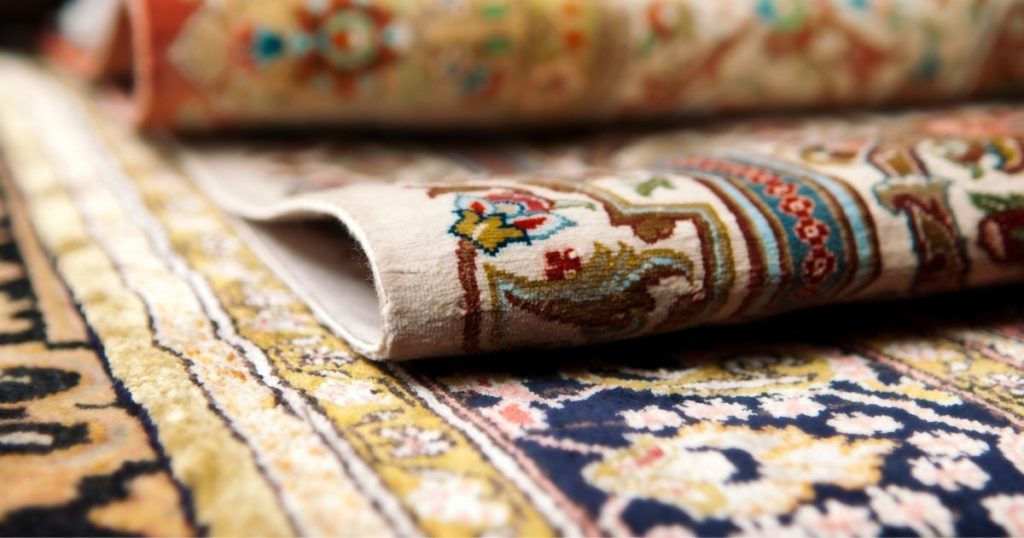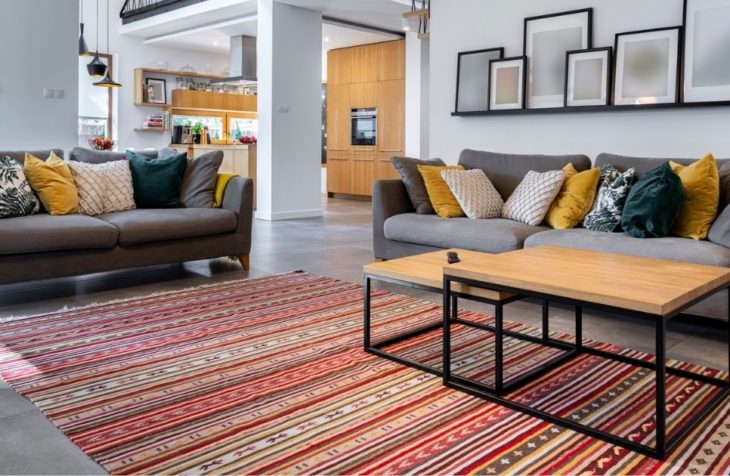Picking a Carpet For Different Rooms In Your House
Carpeting provides a safe, comfortable spot for kids to play and may even reduce the risk of injury during a fall. Sure, it does require a bit of extra maintenance compared to vinyl or tile, but there’s simply no substitute in terms of sound absorption, warmth, and overall comfort.
Here are a few basic tips to keep in mind if you’re getting ready to shop for new carpeting.
1. Set A Budget
Determining your budget is probably the most important step in the entire process. Carpeting prices depend on the square footage of the room, so be sure to measure your space before going to the store.
once you have a firm budget in mind, you’ll save time at the store because you’ll know which carpets you can afford and be able to more easily identify the highest quality options within your price range.
2. Select Your Carpet Provider with Care
You can purchase carpets in a variety of places – carpet showrooms, of course, but also flooring companies, furniture stores, large department stores, and even online.
While you can end up with a beautiful carpet that’s expertly installed using any of these options, your best bet is to select a reputable establishment that specializes in carpeting.
A quality carpet store will carry a large, varied carpet selection, including different fiber options such as wool, synthetics, blends, sisal, linen, jute, coir, and woven vinyl. Staffers should be able to easily answer all of your questions and let you take samples home.
The quality of your carpet’s installation is just as important as the quality of the carpet itself. A second-rate job can leave you with obvious seams, lumps, bumps, and other issues, so look for stores that employ their own installers.
This can be difficult, as most carpet dealers use subcontractors. While subcontracted carpet installers aren’t necessarily inexperienced, they do tend to be less experienced and less skilled than full-time employees.
3. Decide On The Fiber

The kind of fiber determines many of the carpet’s qualities and accounts for 80 percent of its cost.
You can opt for natural or synthetic fibers. Synthetic carpets are usually more budget-friendly as compared to natural ones.
Nylon is typically the most costly synthetic carpeting because it has the softest feel. Polyester carpeting is usually less expensive than nylon and is non-allergenic, making it an ideal choice if you suffer from allergies or asthma.
Because it is an inexpensive material, however, polyester carpeting sometimes presents issues with shedding or pilling.
Before you make your choice, you should look at a number of factors.
The level of traffic
Is the carpet for a bedroom, where there will be minimal wear and tear? Or a family room, where there will be more? Or a hallway or stairway, which receives the most?
What is your budget?
Prices vary quite widely. You should look for the best value that you can afford.
The moisture level of a space
Carpet for a bathroom, kitchen, basement, or pool area may be exposed to dampness. Some fibers tolerate it, some don’t.
The durability of the carpet
Do you want the carpet to last for decades? Or are you planning to replace it in a few years?
Children and pets
Are there likely to be spills and accidents? Are kids playing on the floor? You should consider these things before choosing a fiber.
4. Get The Color Right

A neutral-colored carpet, such as tan, brown, or gray, is a safe option since it will work with virtually any wall or decor color.
But it’s usually best to avoid carpets that are extremely light like white or beige because they don’t hide dirt as easily as darker carpeting. If you have more colorful tastes, don’t be afraid to try a bold-colored carpet in your bedroom.
With light-colored walls, carpeting in a rich shade of blue, green, or red can add visual interest and dimension to the room.
Remember your carpet will be a major component in your room for several years. Select a color that will look as fresh in five years as it does when it is installed.
Here are more tips for making the best color choice for any room in your house.
Contrast is a good thing. You do not want to “match” your new carpet to the wall color or other flooring in the home. You want to pick a carpet color that Coordinates with the home and shares the same color family.
Pick a theme
Warm, Cool, or Greige. If you have warm walls, stick with earth tone colors (beige, cream, etc). If you have cool or grey walls, stick with a cooler-colored carpet. If you want a carpet that can work with both cool walls and warm walls then check out greige-colored carpets.
Greige (or taupe in some cases) can be an excellent middle-of-the-road neutral color that works well in both warm and cool-colored homes.
Light and dark colors pros and cons
The great thing about light colors is their ability to make the room feel larger. The darker colors are great for hiding dirt and spills from kids.
Consider the size of your room
Create the illusion of a larger room with a light, solid color carpet. It can make your room feel open and airy. Medium or deep colors can make a large room feel more intimate and cozy.
Observe the amount of natural light entering your room
If the space tends to be dark, choose a carpet in a light color to help brighten the space. A pale earth tone, yellow or soft green can be pleasing. If the room is naturally sunny, you can install a deeper color if you prefer.
5. Choose The Right Style

Carpets come in many styles, including plush, Saxony, Berber, textured, and frieze. These terms apply to its pile, which is the surface you see, created from yarn tufts that are either folded over into loops, cut straight across, or both.
While each style has a distinctive look, that shouldn’t be your main consideration. Instead, look at how well your lifestyle meshes with a particular carpet style.
Examples of things to guide your carpet style choice.
- Pile Choices
- Look and Feel
- Durability
- Tracks and Imprint
The various carpet styles are as follows.
Plush carpeting, is made from the tightly twisted pile, and is thick, soft, and inviting. But it also shows footprints and vacuum tracks and can develop something called “pooling,” or areas that appear shaded because the normal direction of the carpet fibers has been reversed.
Saxony, the most common type of carpeting, is similar to plush. These carpet styles work best in low-traffic areas like formal living rooms and master bedrooms.
Berber carpeting, in contrast, is crafted from continuous fiber loops and is flat and dense. It can have a level loop, cut-and-loop, or multi-level loop design. All of these attributes mean Berber is extremely durable and doesn’t show tracks, soil, and stains – perfect for high-traffic areas, or places frequented by kids.
Textured carpeting, is made from fibers cut to different heights, which causes them to reflect light. This makes it difficult to see tracks and dirt. So this type of carpeting is also great for high-traffic areas. Some Berbers are textured.
Friezes are cut-pile carpets made from slightly twisted fibers. The look is less formal than plush but fancier than many textured pieces or Berber. The carpet feels soft on your feet, yet its fuzziness hides footprints and dirt well.
Selecting the right rug all depends on which room you’re designing.
It shouldn’t be the dominant element in the room but a part of the overall scheme.
6. Understand Maintenance Requirements
One of the best ways to ensure you’ll be satisfied with your new carpet is to stick with carpeting you can maintain easily.
Always ask a salesperson about cleaning and maintenance requirements before you commit to buying. Find out how often you’ll need to clean and what special equipment or products the manufacturer recommends.
Skip carpets with extensive maintenance requirements unless you have the extra time to perform these tasks.
Choosing the perfect rug for each space in your home
Each room has different demands. So, you need to pick a rug based on the demands of each space.
1. Living Room
Living rooms typically feature beautiful flooring, whether it’s wood or tile, so skip a wall-to-wall rug. The carpet should be small enough to showcase at least a trimming of the floor. If your living room is a high-traffic area, a wool pile cut rug is most preferable.
Wool is easier to clean than silk, cotton, or nylon, and it’s easier to scrub the dirt out from underneath the threads of cut pile rugs than loop pile rugs (in which stubborn dirt can get caught).
This cozy wool carpet is a perfect example of how to place a carpet in your living room.
Have an oddly-shaped living room? Get creative: Layer a few thin rugs to fit the room’s shape, or arrange a group of, say, small antique rugs throughout the space.
You want either all the furniture to sit on top of the rug comfortably or all the front legs to be on the rug.
2. Bedroom
A bedroom rug should establish the room as your quiet, peaceful retreat. This cozy carpeted bedroom shows how much change a carpet can bring. Bedrooms are places with low traffic mostly. So, apart from practicality, they give you a chance to be sophisticated like using plush, round or oversized carpets.
In the bedroom, avoid loud, bold rug patterns that might be disruptive to the peaceful environment. Stick to cotton, wool, or silk, and avoid vinyl carpets or rugs that have quirky features like metal threads.
If you put the carpet in front of the bed, when you wake up and put your legs down then before touching the floor, the smooth carpet will be good for your body temperature.
As for sizing? Go big. The rug should frame the bed. That means you need an 8×10 for a queen and 9×12 for a king. The front feet of bedside tables can sit on the edge.
3. Dining Room
A dining room rug is a backdrop for family gatherings and holidays.
When choosing a carpet for the dining room, a cut pile wool carpet would work best. With all the dragging of chairs across it and potential food or wine spills, it is the most user-friendly to clean and withstand wear.
Let the chairs guide you. The rug needs to be large enough that the chairs remain on it even when pushed back from the table.
In this dining room, the carpet suits the high traffic and also the dragging of chairs.
4. Bathroom
It’s worth it to invest in a high-quality carpet for this utilitarian space. Look for cozy, comfortable rugs that are soft and absorbent under your bare feet — especially if you’ll be stepping on it after exiting the shower.
Another approach to take in the bathroom: is light and clean. Cooler colors, such as light blue, lend the bathroom a sanitary aesthetic. Keep in mind that rugs are best used in full-sized bathrooms, and not smaller powder rooms (which may force a rug to be uncomfortably close to the toilet).
The main things to look for:
- Water-resistant or washable carpets
- Waterproof waffle-backed carpets
- Carpets made from natural materials such as cotton or wool. Some synthetics such as nylon dry quickly as well
5. Stairs
Carpeting a staircase needs a little more consideration than the other rooms or areas of the house. Because the stairs get the heaviest footfall, the carpet needs to be hard-wearing enough to stand up to wear and tear. It should be easy to clean and resistant to dirt and other stains. And for safety, it can’t be too thick that it causes you to trip on your way down.
You also want it to look good!
Unfortunately, it’s not as easy as going with the carpets you used throughout the rest of your home.
One of the great things about carpet is that it cushions every step and helps reduce the noise of you and your family’s daily movement up and downstairs.
It’s crucial that you choose a carpet for your staircase that is durable, strong, and tough enough to last.
